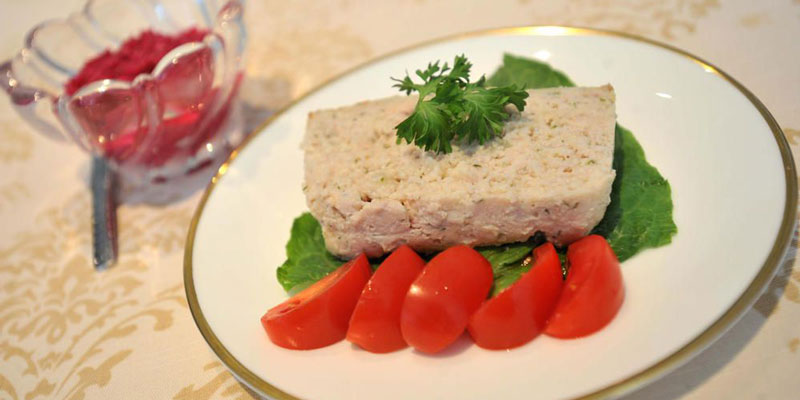The carp family is given a good bouncing in the bathtub before being gutted, and placed back into its skin. Alternatively, it might be poached or served in a walnut sauce for the Passover Seder. Or it turns out to be globs of thick fish jelly suspended in an unholy slop, condemned to the status of a culinary joke used only occasionally to freak out the youngsters.
To an Ashkenazi Jew, gefilte fish, or "stuffed fish" in Yiddish, is one of the few delicacies that represents their heritage. It's possible that when you mention "Jewish food," non-Jews picture bagels. However, most Jews would probably rather receive credit for the latter. A true Ashkenazi Jew will tell you that gefilte fish is the culinary equivalent of mishpocha.
Prepared Fish Gefilte for the Lenten Season

In his 2010 book, Encyclopedia of Jewish Food, Gil Marks traces the history of gefilte fish back to its non-Jewish roots. He starts with the Ancient Romans, who he claims routinely skinned animals, chopped up the meat, and stuffed it back into the skin before cooking. According to his research, the earliest German cookbook, published around 1350, is the first non-Jewish source to mention the fish dish, gestalten supporters.
A Meal Prepared with Banned Ingredients
In the Middle Ages, after the first stuffed fish recipe was documented in that German cookbook, gefilte fish began to transition from a popular Gentile dish to the centerpiece of Ashkenazi Jewish holiday dinners.
Cultural and culinary historian Andás Koener, who primarily studies pre-Shoah Hungarian Jewry, discusses how gefilte fish fit into the traditions of religiously devout Jews, assuming they adopted the dish at all. "According to these Jews, many of whom were of Galician descent, extracting the bones from the fish was similar to 'borer,' that is, separating unwanted portions from a mixture of edible and inedible substances, and this was an activity banned on Saturdays.
The Ashkenazi Jewish family's origins primarily determined whether or not gefilte fish was a staple dish. Jews who adhered more closely to tradition in Poland, Ukraine, Russia, and northeastern Hungary prepared gefilte fish.
Symbolic Nutrients
Shabbat fish dishes are traditionally served as the first course because of their symbolic significance. According to Koerner's 2019 best-selling book, Jewish Cuisine in Hungary, "fish is a significant symbol in other religions, too, but in Judaism more symbolic significance are linked to it than to any other meal, save for bread."
The advent of the Messianic Age is just one meaning for this sign of good fortune, wealth, and fertility. Since the Babylonian Talmud was compiled around 500 C.E., eating fish has been associated with Shabbat celebrations. The Talmud is a collection of Rabbinic writings on Jewish civil and ceremonial law. Simply put, it's a rabbinical debate that goes above and beyond the call of duty.
Traveling To The United States

So far, we've been describing a meal that would typically arrive on the Shabbat table as a complete fish, head, and all. In modern times, however, most Jews associate gefilte fish with dumplings baked or poached and topped with sliced carrots.
Maybe you're seeing Bill Murray covered in ectoplasm goo from the Ghostbusters scene, or you're picturing a Manischewitz glass jar full of oddballs floating about in a jellied soup. Ashkenazi Jewish immigration to the United States is mainly responsible for the widespread acceptance and popularity of gefilte fish and the dish's distinctive ball or dumpling shape.
The most common kind of gefilte fish among Eastern European Jews dates back centuries when some chefs began skipping the filling step altogether and poaching the seasoned mixture as a fish dumpling.
Spicy Veracruz-Style Fish Fillets
Gefilte fish has never inspired the same love-hate reaction among Mexican-Jewish communities as it has among American-Jewish communities. This is because Ashkenazi Jews also brought the dish over and gave it their unique spin throughout time. The Jewish-Mexican cookbook author and PBS cooking show host Pati Jinich has announced that she will be cooking with gefilte fish in her upcoming season.
Her ancestors came to the United States through the Gulf Coast state of Veracruz, as did many other Jewish families from Lebanon, Africa, Asia, and elsewhere. According to Jinich, the fish in Veracruz has been prepared in a certain way for generations.



